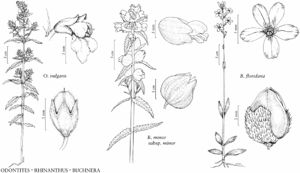Rhinanthus
Sp. Pl. 2: 603. 1753.
| Taxon | Illustrator ⠉ | |
|---|---|---|
 | Odontites vulgaris Rhinanthus minor subsp. minor Buchnera floridana | Yevonn Wilson-Ramsey Barbara Alongi Yevonn Wilson-Ramsey |
Herbs, annual; hemiparasitic. Stems erect, not fleshy, glabrous, hairy on 2 opposite sides. Leaves cauline, opposite; petiole present or absent; blade not fleshy to moreorless fleshy, not leathery, margins coarsely toothed distally. Inflorescences terminal, racemes, moreorless secund; bracts present. Pedicels present; bracteoles absent. Flowers: sepals 4, calyx bilaterally symmetric, flattened laterally, ovate to suborbiculate, accrescent in fruit, lobes deltate; petals 5, corolla yellow or yellowish [bronze to bluish], compressed, strongly bilabiate, narrowly campanulate, abaxial lobes 3, adaxial 2, adaxial lip galeate, ovate, obtuse, entire, with subapical tooth on each side; stamens 4, didynamous, filaments lanate; staminode 0; ovary 2-locular, placentation axile; stigma capitate. Capsules: dehiscence loculicidal longitudinally. Seeds 2–10 [+], brown, kidney-shaped, flattened, wings present, absent in some R. major. x = 11.
Distribution
North America, Europe, n Asia
Discussion
Species ca. 50 (2 in the flora).
Although the taxonomy of Rhinanthus in the Old World is complex, the taxa found in North America are reasonably distinct. The subapical teeth on the adaxial corolla lip have been described as galea or nipples; the term teeth is used in this account. Leaf measurements are for mid-stem leaves; calyx features are for post-anthesis calyces.
The European species Rhinanthus serotinus (Schönheit ex Halácsy & H. Braun) Oborný has been reported from Maine (E. Hultén and M. Fries 1986); the authors have found no specimens to substantiate this report. If it were to be encountered in North America, it would key to R. major, from which it can be distinguished by having narrowly triangular bracts and glabrous calyces as in R. minor.
Selected References
None.
Lower Taxa
Key
| 1 | Corollas 15–20 mm; teeth of galea of corolla 1.5–2.5 mm; calyces villous, glabrescent. | Rhinanthus major |
| 1 | Corollas 13–15 mm; teeth of galea of corolla (0.4–)0.6–1 mm; calyces glabrous, scabrid, or puberulent. | Rhinanthus minor |